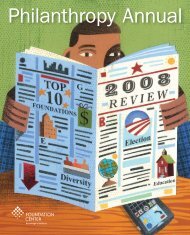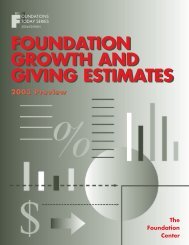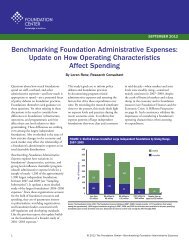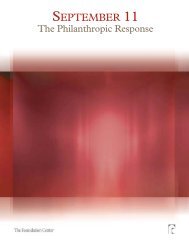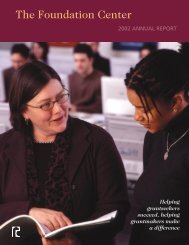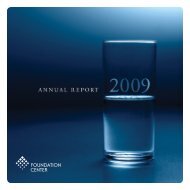Download Philanthropy Annual PDF - Foundation Center
Download Philanthropy Annual PDF - Foundation Center
Download Philanthropy Annual PDF - Foundation Center
You also want an ePaper? Increase the reach of your titles
YUMPU automatically turns print PDFs into web optimized ePapers that Google loves.
TopStoriesintheNews<br />
nonprofit groups — two favoring<br />
reform of existing drug laws and an<br />
anti-abortion group — from the contest<br />
as their vote totals mounted resulted in<br />
a flurry of critical blog posts, online<br />
social media-based giving campaigns<br />
seemed to be here to stay.<br />
That view was echoed by Case<br />
<strong>Foundation</strong> CEO Jean Case, whose<br />
foundation, in partnership with Parade<br />
magazine, helped pioneer the social<br />
media giving campaign. “From our<br />
very first experiences with social media<br />
prior to the launch [of America’s Giving<br />
Challenge on Facebook], we recognized<br />
the powerful potential to bring communities<br />
together around issues for which<br />
they shared a passion,” said Case. “[W]e<br />
believe that the prospects for robust participation<br />
by nonprofits are better today<br />
than they were in the first challenge, and<br />
we are heartened to see that nonprofits<br />
have embraced the rapid growth in social<br />
media with enthusiasm.”<br />
Related stories from<br />
<strong>Philanthropy</strong><br />
News Digest:<br />
http://foundationcenter.org/pnd/<br />
> “MacArthur <strong>Foundation</strong> Announces<br />
Winners of 2009 Digital Media<br />
and Learning Competition”<br />
(4/17/09)<br />
> “Online Contests Represent<br />
Potential ‘Jackpots’ for Charities”<br />
(5/13/09)<br />
> “MacArthur <strong>Foundation</strong> Launches<br />
Virtual Island in Second Life”<br />
(5/24/09)<br />
> “US Twitter Usage Surpasses<br />
Earlier Estimates” (9/14/09)<br />
> “Case <strong>Foundation</strong> Launches<br />
Initiative to Help Nonprofits<br />
Leverage Social Media” (9/6/09)<br />
GO<br />
> “2009 America’s Giving Challenge<br />
Winners Announced” (11/26/09)<br />
<strong>Philanthropy</strong> and<br />
the Future of Journalism<br />
Of all the economy-driven stories of the year, the<br />
near-death — or, as some would have it, suicide —<br />
of the newspaper industry may have been the most<br />
avidly followed and hotly debated. Needless to say, it<br />
was a dismal year for all but a few papers.<br />
y the end of the first quarter,<br />
the Los Angeles Times, Chicago<br />
Tribune, and Philadelphia<br />
Inquirer had sought Chapter<br />
11 bankruptcy protection, the Seattle<br />
Post-Intelligencer had stopped publishing<br />
a print edition, and the Rocky Mountain<br />
News, Colorado’s oldest newspaper,<br />
had closed its doors entirely. As the<br />
recession dragged on and circulation<br />
and advertising revenues continued<br />
to fall, other newspapers across the<br />
country were forced to make layoffs,<br />
scale back home delivery, and scramble<br />
to find cost-saving measures.<br />
But as bad as it was, media experts<br />
seemed to agree that the industry had<br />
not bottomed out. According to U.S.<br />
Bureau of Labor Statistics data published<br />
in Editor & Publisher magazine —<br />
which was shuttered at the end of the<br />
year by its parent the Nielsen Co. after<br />
125 years as a going concern — the<br />
industry will lose nearly 25 percent of<br />
its jobs by 2018.<br />
Such dire projections made it clear<br />
that journalism, in order to thrive in the<br />
twenty-first century, needs a new business<br />
model — and one of the options<br />
most frequently mentioned was the<br />
not-for-profit model. In March, Sen. Ben<br />
Cardin (D-MD) introduced legislation<br />
(S. 673) that would allow newspapers to<br />
become tax-exempt, nonprofit organizations<br />
and operate in a manner similar to<br />
public broadcasting stations; in September,<br />
Rep. Carolyn Maloney (D-NY)<br />
offered a companion bill (H.R. 3602)<br />
in the House, saying that “Unless something<br />
is done, and done fast, it’s likely<br />
that many metropolitan areas may soon<br />
have no local daily newspapers — and<br />
that would damage our democracy.”<br />
<strong>Foundation</strong>s also were looked to in<br />
some quarters to provide a solution to<br />
the industry’s plight — and a number<br />
responded. In May, John S. and James L.<br />
Knight <strong>Foundation</strong> president Alberto<br />
Ibargüen was one of six media thought<br />
leaders to testify before Congress about<br />
the future of journalism and how<br />
government can help ensure that communities’<br />
information needs are met<br />
during the transition to new models<br />
and platforms. Knight, which under<br />
Ibargüen’s leadership has invested more<br />
than $100 million in projects that could<br />
help shape journalism in the digital<br />
age, wasn’t alone. In June, the Henry J.<br />
Kaiser Family <strong>Foundation</strong> announced<br />
the launch of a nonprofit news service<br />
dedicated to major health policy issues<br />
in the United States; in August, the<br />
Chicago Community Trust announced<br />
the creation of Community News<br />
Matters, an initiative designed to spur<br />
the growth of new sources of quality<br />
local news and information about the<br />
Chicago region; and in September, the<br />
California HealthCare <strong>Foundation</strong> and<br />
Annenberg School for Communication<br />
at the University of Southern California<br />
in Los Angeles announced a partnership<br />
to provide in-depth, impartial reporting<br />
on health policy issues in the state.<br />
continues on page 10<br />
Top Stories in the News | 9



